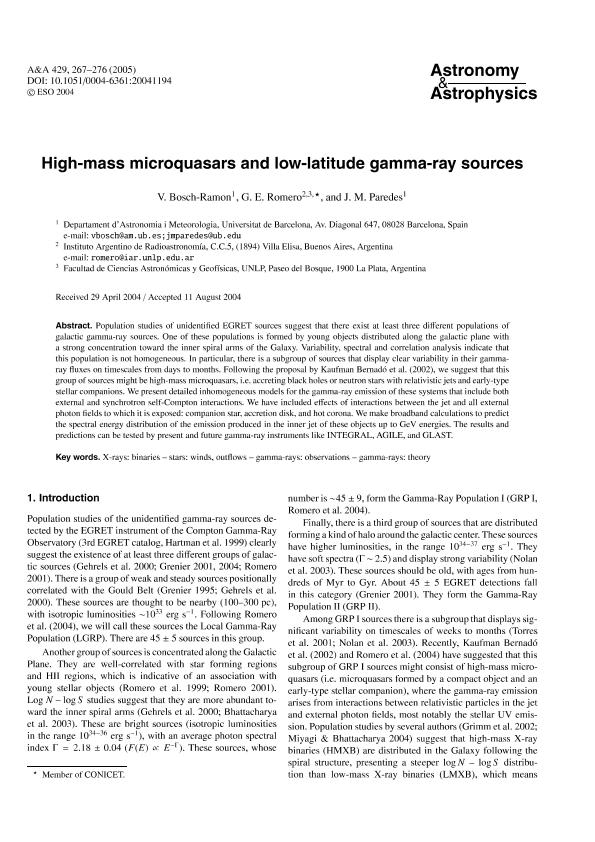Mostrar el registro sencillo del ítem
dc.contributor.author
Bosch Ramon, Valentí

dc.contributor.author
Romero, Gustavo Esteban

dc.contributor.author
Paredes, Josep Maria

dc.date.available
2017-11-08T16:55:58Z
dc.date.issued
2004-12
dc.identifier.citation
Bosch Ramon, Valentí; Romero, Gustavo Esteban; Paredes, Josep Maria; High-mass microquasars and low-latitude gamma-ray sources
; EDP Sciences; Astronomy and Astrophysics; 429; 12-2004; 267-276
dc.identifier.issn
0004-6361
dc.identifier.uri
http://hdl.handle.net/11336/27845
dc.description.abstract
Population studies of unidentified EGRET sources suggest that there exist at least three different populations of galactic gamma-ray sources. One of these populations is formed by young objects distributed along the galactic plane with a strong concentration toward the inner spiral arms of the Galaxy. Variability, spectral and correlation analysis indicate that this population is not homogeneous. In particular, there is a subgroup of sources that display clear variability in their gamma-ray fluxes on timescales from days to months. Following the proposal by Kaufman Bernadó et al. (2002), we suggest that this group of sources might be high-mass microquasars, i.e. accreting black holes or neutron stars with relativistic jets and early-type stellar companions. We present detailed inhomogeneous models for the gamma-ray emission of these systems that include both external and synchrotron self-Compton interactions. We have included effects of interactions between the jet and all external photon fields to which it is exposed: companion star, accretion disk, and hot corona. We make broadband calculations to predict the spectral energy distribution of the emission produced in the inner jet of these objects up to GeV energies. The results and predictions can be tested by present and future gamma-ray instruments like INTEGRAL, AGILE, and GLAST.
dc.format
application/pdf
dc.language.iso
eng
dc.publisher
EDP Sciences

dc.rights
info:eu-repo/semantics/openAccess
dc.rights.uri
https://creativecommons.org/licenses/by-nc-sa/2.5/ar/
dc.subject
X Ray Binaries
dc.subject
Star Winds
dc.subject
Outflows
dc.subject
Gamma Ray Observations
dc.subject
Gamma Ray Theory
dc.subject.classification
Astronomía

dc.subject.classification
Ciencias Físicas

dc.subject.classification
CIENCIAS NATURALES Y EXACTAS

dc.title
High-mass microquasars and low-latitude gamma-ray sources
dc.type
info:eu-repo/semantics/article
dc.type
info:ar-repo/semantics/artículo
dc.type
info:eu-repo/semantics/publishedVersion
dc.date.updated
2017-10-30T18:42:25Z
dc.journal.volume
429
dc.journal.pagination
267-276
dc.journal.pais
Francia

dc.description.fil
Fil: Bosch Ramon, Valentí. Universidad de Barcelona; España
dc.description.fil
Fil: Romero, Gustavo Esteban. Provincia de Buenos Aires. Gobernación. Comisión de Investigaciones Científicas. Instituto Argentino de Radioastronomía. Consejo Nacional de Investigaciones Científicas y Técnicas. Centro Científico Tecnológico Conicet - La Plata. Instituto Argentino de Radioastronomía; Argentina
dc.description.fil
Fil: Paredes, Josep Maria. Universidad de Barcelona; España
dc.journal.title
Astronomy and Astrophysics

dc.relation.alternativeid
info:eu-repo/semantics/altIdentifier/doi/http://dx.doi.org/10.1051/0004-6361:20041194
dc.relation.alternativeid
info:eu-repo/semantics/altIdentifier/url/https://www.aanda.org/articles/aa/abs/2005/01/aa1194/aa1194.html
Archivos asociados
